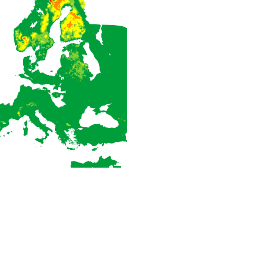Was ist der universelle Pollenindex (UPI)?
Der universelle Pollenindex (UPI) bietet eine weltweit einheitliche Skala zum Vergleich der Pollenbelastung in verschiedenen Gebieten. Der Index hilft, das Risiko einer Pollenexposition anhand verschiedener Faktoren für Menschen mit einer Pollenallergie oder -sensibilität zu bewerten. Es basiert auf einem mehrschichtigen Modell und stellt Daten zum Pollenflug dar, die die Konzentration pro Pflanzenmodell, viele verschiedene weltweit verwendete lokale Pollenindizes (Local Pollen Index, LPI) und die Allergenität verschiedener Pflanzenpollenarten berücksichtigen, um die Anzahl der Pollenkörner pro Kubikmeter (Körner/m³) pro Tag vorherzusagen.
Der Endpunkt „heatmapTiles“ gibt Heatmap-Kacheln zurück, die auf eine Grundkarte gelegt werden können. Auf Heatmap-Kacheln wird der UPI weltweit für einen bestimmten Anlagentyp (TREE, GRASS oder WEED) angezeigt.
Der Index besteht aus sechs Kategorien:
| Wert | Farbe | Beschreibung |
|---|---|---|
| 0 | Keine | |
| 1 | Sehr niedrig | |
| 2 | Niedrig | |
| 3 | Moderat | |
| 4 | Hoch | |
| 5 | Sehr hoch |
Jede Kategorie basiert auf bestimmten Konzentrationswerten von Pollen in einem bestimmten Gebiet und deren Auswirkungen auf den Schweregrad der allergischen Symptome, die normalerweise auftreten. So wird ein umfassendes Bild der Pollenkonzentrationen geboten. Durch die Integration des UPI können Nutzer die Pollenbelastung an verschiedenen Orten vergleichen und bewerten.
Die folgende Heatmap-Kachel zeigt beispielsweise TREE-Pollenwerte von Sehr niedrig bis Sehr hoch:

Unterstützte Pflanzen
Die Pollen API unterstützt drei verschiedene Arten von Pflanzen: Gras, Unkraut und Baum. Da die Verfügbarkeit einer Pflanze von den tatsächlichen Messungen und Berichten der Datenquelle abhängt, können die Pflanzendaten der Pollen API je nach Standort variieren.
In der folgenden Liste sind die unterstützten Werkscodes und ihre Metadaten aufgeführt:
| Werkscode | Anzeigename | Typ |
|---|---|---|
ALDER |
Erle | Baum |
ASH |
Asche | Baum |
BIRCH |
Birke | Baum |
COTTONWOOD |
Cottonwood | Baum |
ELM |
Elm | Baum |
MAPLE |
Maple | Baum |
OLIVE |
Olive | Baum |
JUNIPER |
Juniper | Baum |
OAK |
Eiche | Baum |
PINE |
Pine | Baum |
CYPRESS_PINE |
Schmuckzypresse | Baum |
HAZEL |
Hazel | Baum |
GRAMINALES |
Gräser | Gräser |
JAPANESE_CEDAR |
Japanische Zeder | Baum |
JAPANESE_CYPRESS |
Hinoki-Scheinzypresse | Baum |
RAGWEED |
Ambrosia | Unkraut |
MUGWORT |
Beifuß | Unkraut |

